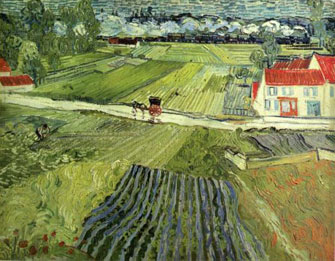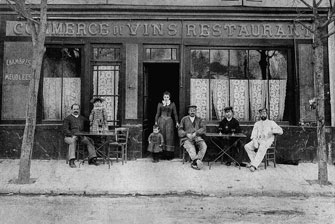Tracking Vincent in
His Final Days

Van Gogh’s “Landscape with Carriage and Train” (1890), a view of Auvers-sur-Oise.
Auvers-sur-Oise, less than 30 kilometers northwest of Paris, was the last stop on Vincent Van Gogh’s artistic journey. He found the village and its bucolic surroundings “gravely beautiful,” he wrote to his brother Theo. The doomed artist spent only 70 days there, a short but intensely creative time that produced nearly 80 paintings – among them “Wheatfield with Crows” and “The Church in Auvers” – before he took his own life in July 1890.
None of the works are still in Auvers, but the landscapes and architecture that inspired Van Gogh (and Pissarro and Cézanne) remain almost intact, attracting some 220,000 tourists annually. The most evocative site is the Auberge Ravoux, beautifully restored and now

The Auberge Ravoux in 1890. © Institut Van Gogh
headquarters of the Institut Van Gogh, where visitors can view the modest garret room he rented (for 3.50 francs, with full board). The restaurant offers the same traditional recipes he enjoyed, such as rabbit pâté and blanquette de veau, at modern prices.
Anticipating the 125th anniversary of the artist’s death next year, the 2014 cultural season in Auvers (April 5-Sept. 21) is entitled “In the Footsteps of Van Gogh.” Hardly a surprise, but it represents a big effort, public and private, to enhance the Van Gogh commemorative experience with fresh material.
Besides snazzy new information panels at key locations around the village, novelties include an exhibition of personal letters at the house of Dr. Gachet, the art-loving physician who took Van Gogh under his care, and, in the Château d’Auvers, 40 paintings by street artist Arnaud Rabier, a.k.a. Nowart, who uses spray paint to reimagine Van Gogh’s experiments with color and motion.
Additional attractions justify spending two days in Auvers to see everything: the ancient Notre Dame Church and the cemetery where Van Gogh and his brother lie side by side in simple ivy-covered graves; the charmingly kitsch Absinthe Museum, offering a dégustation of Van Gogh’s favorite brew in an updated version; the elegant home of 19th-century landscape artist Charles-François Daubigny, decorated with murals by his friends Corot and Daumier; and the Daubigny Museum’s show of contemporary art in the Van Gogh vein, including local photographer Olivier Verley’s haunting depictions in black and white of the Auvers landscapes Van Gogh painted in lurid color.
Making a day trip from Paris even easier, a direct train service is running from April 5 to November 2 on Saturdays, Sundays and holidays, departing the Gare du Nord at 9:38 am to arrive in Auvers at 10:19, and returning at 6:25 pm. When you return to Paris, don’t miss the excellent exhibition “Van Gogh/Artaud: Le Suicidé de la Société” at the Musée d’Orsay.
Click here for further information.
Favorite